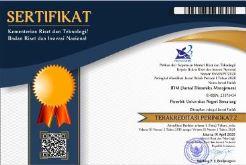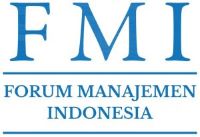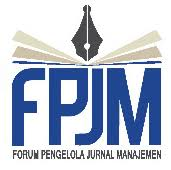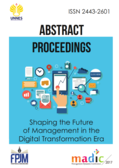‘Monte Carlo’ Simulation Predicting on the Movement of Investments – During the Covid Pandemic in Indonesia
Abstract
The movement of the net asset value (NAV) of mutual fund products (MFP) whether high or low in the Covid-19 pandemic conditions in 2020. With the support of the Monte Carlo Simulation (MCS), this study intends to predict the rate of return on mutual fund investment (MFI) providing a choice of the average demand for return on mutual funds (MFR) that investors need. Analysis of the prediction of NAV movements and the rate of return on MFI in 55 MFP with a trial frequency of 48 times, we get an estimate of the average demand for MFR of 37 out of 100 cumulative numbers of probability distributions. The result is 77.08 percent, and an estimated average MFR in Indonesia during the 2020 Covid-19, the simulation got was IDR 421,954. The contribution resulted in a vital discovery of NAV in Indonesia in response to the economic recession affected by Covid-19..
Keywords
Full Text:
PDFReferences
Acebes, F., Pereda, M., Poza, D., Pajares, J., & Galán, J. M. (2015). Stochastic Earned Value Analysis Using Monte Carlo Simulation and Statistical Learning Techniques. International Journal of Project Management, 33(7), 1597–1609.
Amédée‐Manesme, C., Barthélémy, F., Baroni, M., & Dupuy, E. (2013). Combining Monte Carlo Simulations and Options to Manage the Risk of Real Estate Portfolios. Journal of Property Investment & Finance, 31(4), 360-389.
Azis, M., Burhanuddin, B., & Rahayu, H. (2021). Stock Price of Pandemic Covid-19 in Stock Market Performance. Universal Journal of Accounting and Finance, 9(2), 184-190
Azis, M., Hadjaat, M., Rositawati, R., & Darma, D. C. (2021). Evaluation of Systematic Risk, Corporate Governance, and Cash Holdings: Evidence from Indonesia. Economics of Development, 20(1), 35-45.
Balogh, P., Golea, P., & Inceu, V. (2013). Profit Forecast Model Using Monte Carlo Simulation in Excel. Romanian Statistical Review, 61(12), 33-40.
Biondi, B., Cornelsen, L., Mazzocchi, M., & Smith, R. (2020). Between Preferences and References: Asymmetric Price Elasticities and the Simulation of Fiscal Policies. Journal of Economic Behavior & Organization, 180, 108–128.
Blasques, F., Lucas, A., & van Vlodrop, A. C. (2020). Finite Sample Optimality of Score-Driven Volatility Models: Some Monte Carlo Evidence. Econometrics and Statistics, 19, 47-57.
Buchner, A. (2015). Equilibrium Option Pricing: a Monte Carlo Approach. Finance Research Letters, 15, 138–145.
Casari, M. (2008). Markets in Equilibrium with Firms Out of Equilibrium: a Simulation Study. Journal of Economic Behavior & Organization, 65(2), 261–276.
Castañeda, P., & Reus, L. (2019). Suboptimal Investment Behavior and Welfare Costs: a Simulation Based Approach. Finance Research Letters, 30, 170–180.
Chen, N., & Huang, Z. (2012). Brownian Meanders, Importance Sampling and Unbiased Simulation of Diffusion Extremes. Operations Research Letters, 40(6), 554–563.
Chen, S-H., & Huang, Y-C. (2008). Risk Preference, Forecasting Accuracy and Survival Dynamics: Simulations based on a Multi-Asset Agent-Based Artificial Stock Market. Journal of Economic Behavior & Organization, 67(3–4), 702–717.
Chou, J-S. (2011). Cost Simulation in an Item-Based Project Involving Construction Engineering and Management. International Journal of Project Management, 29(6), 706–717.
Davies, R., Coole, T., & Osipyw, D. (2014). The Application of time Series Modelling and Monte Carlo Simulation: Forecasting Volatile Inventory Requirements. Applied Mathematics, 5(8), 1152-1168.
Denault, M., & Simonato, J-G. (2017). Dynamic Portfolio Choices by Simulation-and-Regression: Revisiting the Issue of Value Function vs Portfolio Weight Recursions. Computers & Operations Research, 79, 174–189.
Driessen, J., Lin, T., & Phalippou, L. (2012). A New Method to Estimate Risk and Return of Nontraded Assets from Cash Flows: the Case of Private Equity Funds. Journal of Financial and
Quantitative Analysis, 47(3), 511-535.
Ferrer, A., Casals, J., & Sotoca, S. (2016). Efficient Estimation of Unconditional Capital by Monte Carlo Simulation. Finance Research Letters, 16, 75–84.
Fortmann-Roe, S. (2014). Insight Maker: A General-Purpose Tool for Web-Based Modeling & Simulation. Simulation Modelling Practice and Theory, 47, 28–45.
Geni, B. Y., Santony, J., & Sumijan, S. (2019). Prediksi Pendapatan Terbesar pada Penjualan Produk Cat dengan menggunakan Metode Monte Carlo. Jurnal Informatika Ekonomi Bisnis, 1(4), 15-20.
Ghodrati, H., & Zahiri, Z. (2014). A Monte Carlo Simulation Technique to Determine the Optimal Portfolio. Management Science Letters, 4(3), 465–474.
Gimpelevich, D. (2011). Simulation-based Excess Return Model for Real Estate Development: a Practical Monte Carlo Simulation-Based Method for Quantitative Risk Management and Project Valuation for Real Estate Development Projects Illustrated with a High-Rise Office Development Case Study. Journal of Property Investment and Finance, 29(2), 115–144.
Goda, T. (2017). Computing the Variance of a Conditional Expectation via non-nested Monte Carlo. Operations Research Letters, 45(1), 63–67.
Haryanto, S. (2016). Profitability Identification of National Banking Through Credit, Capital, Capital Structure, Efficiency, and Risk
Level. Jurnal Dinamika Manajemen, 7(1), 11-21.
Kang, W., Kim, K-K., & Shin, H. (2012). Denoising Monte Carlo Sensitivity Estimates. Operations Research Letters, 40(3), 195–202.
Lai, S-K. (2018). A Simulation Model for Urban Development in China. Journal of Urban Management, 7(1), 1–5.
Lee, C-H., Yang, C-B., & Chen, H-H. (2014). Taiwan Stock Investment with Gene Expression Programming. Procedia Computer Science, 35, 137–146.
León, A., & Vaello-Sebastià, A. (2010). A Simulation-Based Algorithm for American Executive Stock Option Valuation. Finance Research Letters, 7(1), 14–23.
Li, C., Xu, W., Huang, S., & Yang, L. (2020). A Monte Carlo Tree Search-Based Method for Online Decision Making of Generator Startup Sequence Considering Hot Start. International Journal of Electrical Power & Energy Systems, 121, 106070.
Li, D., Clements, A., & Drovandi, C. (2020). Efficient Bayesian Estimation for GARCH-type Models via Sequential Monte Carlo. Econometrics and Statistics, 19, 22-46.
Livingston, M., Yao, P., & Zhou, L. (2019). The Volatility of Mutual Fund Performance. Journal of Economics and Business, 104, 105835.
Melouk, S. H., Fontem, B. A., Waymire, E., & Hall, S. (2014). Stochastic resource Allocation Using a Predictor-Based Heuristic for Optimization via Simulation. Computers & Operations Research, 46, 38–48.
Mohanti, D., & Priyan, P. K. (2018). Style-Exposure Analysis of Large-Cap Equity Mutual Funds in India. IIMB Management Review, 30(3), 219–228.
Nadarajah, S., & Secomandi, N. (2017). Relationship between Least Squares Monte Carlo and Approximate Linear Programming. Operations Research Letters, 45(4), 409–414.
Neaime, S. (2015). Are Emerging MENA Stock Markets Mean Reverting? a Monte Carlo Simulation. Finance Research Letters, 13, 74–80.
Ng, S. T., Xie, J., Cheung, Y. K. & Jefferies, J. M. (2007). A Simulation Model for Optimizing the Concession Period of Public-Private Partnerships Schemes. International Journal of Project Management, 25(8), 791–798.
Nugroho, A. C., & Stoffers, J. (2020). Market Competition and Agency Problem: a Study in Indonesian Manufacturing Companies. Jurnal Dinamika Manajemen, 11(1) , 65-77.
Parsa, V. A., & Salehi, E. (2016). Spatio-Temporal Analysis and Simulation Pattern of Land Use/Cover Changes, Case Study: Naghadeh, Iran. Journal of Urban Management, 5(2), 43–51.
Piranfar, H., & Masood, O. (2012). Measuring Risk and Financial Support for NPPs using Monte Carlo Simulation. Journal of Risk Finance, 13(2), 160-170.
Raggi, D., & Bordignon, S. (2006). Comparing Stochastic Volatility Models through Monte Carlo Simulations. Computational Statistics & Data Analysis, 50(7), 1678–1699.
Rahmayani, D., & Oktavilia, S. (2021). Does the Covid-19 Pandemic affect the Stock Market in Indonesia?. Jurnal Ilmu Sosial dan Ilmu Politik, 24(1), 33-47.
Righi, M. B., & Borenstein, D. (2018). A Simulation Comparison of Risk Measures for Portfolio Optimization. Finance Research Letters, 24, 105–112.
Rossi, E., & Spazzini, F. (2010). Model and Distribution Uncertainty in Multivariate GARCH Estimation: a Monte Carlo Analysis. Computational Statistics & Data Analysis, 54(11), 2786–2800.
Roy, V., & Hobert, J. P. (2010). On Monte Carlo methods for Bayesian Multivariate Regression Models with Heavy-Tailed Errors. Journal of Multivariate Analysis, 101(5), 1190-1202.
Sanford, A. D., & Martin, G. M. (2005). Simulation-based Bayesian Estimation of an Affine Term Structure Model. Computational Statistics & Data Analysis, 49(2), 527–554.
Safitri, K. (2020). 6 bulan pandemi Covid-19, Bagaimana Dampaknya ke pergerakan Saham di Indonesia?. Retrieved from https://money.kompas.com/read/2020/09/02/155619126/6-bulan-pandemi-covid-19-bagaimana-dampaknya-ke-pergerakan-saham-di-indonesia?page=all
Takagi, K., Otaki, M., & Otaki, Y. (2018). Potential of Rainwater Utilization in Households Based on the Distributions of Catchment Area and End-Use Water Demand. Water, 10(12), 1706.
Tjahjono, E. D., Hutabarat, A. R., Haryono, E., Majardi, F., & Pramono, B. (2003). Pengukuran Inflasi Inti (core inflation) di Indonesia. Buletin Ekonomi Moneter dan Perbankan, 2(4), 1-34.
Tompkins, R. G., & D’Ecclesia, R. L. (2006). Unconditional Return Disturbances: a Non-Parametric Simulation Approach. Journal of Banking & Finance, 30(1), 287–314.
Tüzüntürk, S., Şenaras, A. E., & Sezen, K. (2015). Forecasting Water Demand by using Monte Carlo Simulation. Akademđk Bakiş Dergđsđ, 49, 25-44.
Vasu, E. S. (1978). Multiple Regression with Varying Levels of correlation Among Predictors: Monte Carlo Sampling from Normal and Non-Normal Populations. Educational and Psychological Measurement, 38(3), 633–645.
Vagnani, G. (2009). The Black-Scholes Model as a Determinant of the Implied Volatility Smile: a Simulation Study. Journal of Economic Behavior & Organization, 72(1), 103–118.
Voynarenko, M., Hurochkina, V., Sushkova, O., & Yepifanova, I. (2021). Beneficial Ownership Chain and its Evaluation Arrangement. Estudios de Economía Aplicada, 38(4), 1-9.
Wee, D. C., Chen, F., & Dunsmuir, W. T. (2020). Likelihood Inference for Markov Switching GARCH(1,1) Models using Sequential Monte Carlo. Econometrics and Statistics, 1, 1–19.
Wong, Z. W. V., Chen, F., & Yiew, T. H. (2021). Effects of Rent-Seeking on Economic Growth in Low-Income Economies. Buletin Ekonomi Moneter dan Perbankan, 24(2), 205-220.
Yang, I. T. (2005). Simulation-based Estimation for Correlated Cost Elements. International Journal of Project Management, 23(4), 275–282.
Yu, T-Y., & Huang, H-T. (2013). Coupling a Memetic Algorithm to Simulation Models for Promising Multi-Period Asset Allocations. Computers & Operations Research, 40(1), 2585–2597.
View Counter: Abstract - 2181 and PDF - 1057
Refbacks
- There are currently no refbacks.






